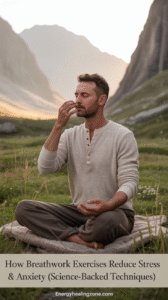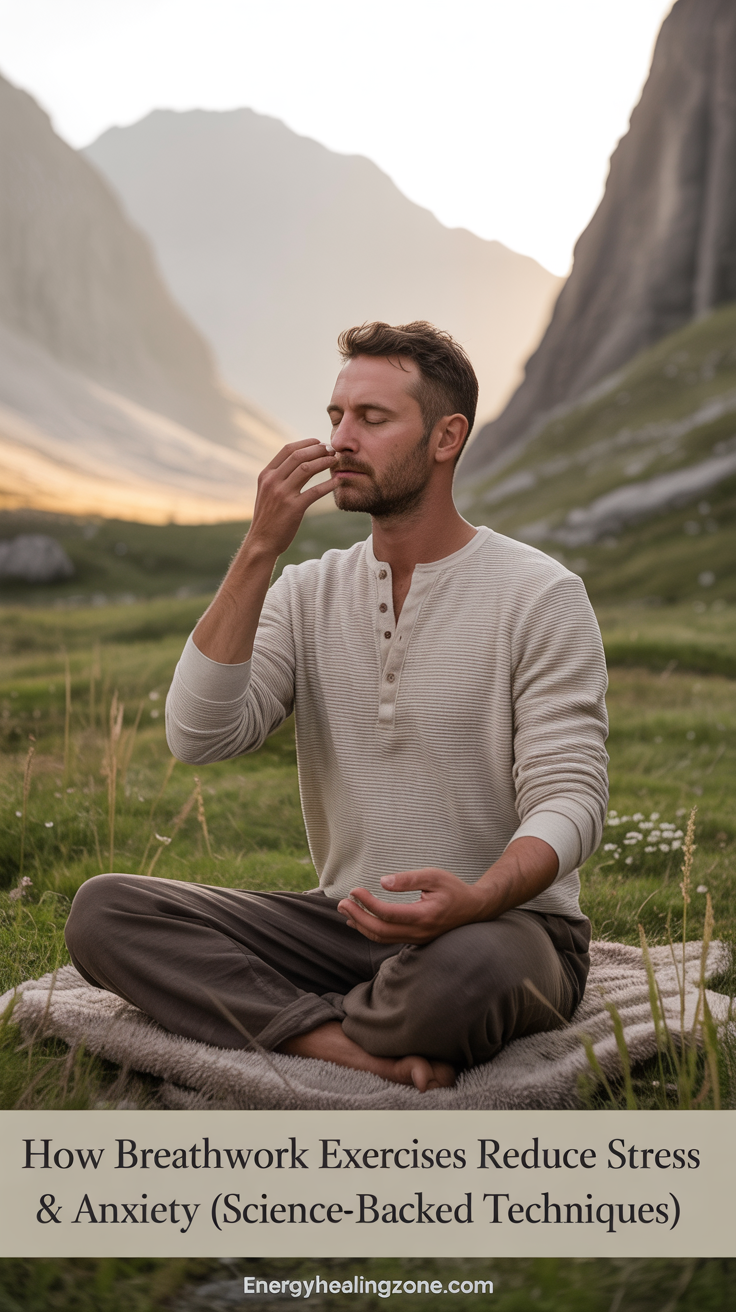We often overlook the power of our breath. Yet, it’s the key to finding calm and balance. Breathwork exercises have been shown to lower stress and anxiety. They work by changing how our body reacts to stress.
By controlling our breathing, we can soothe our nervous system. This helps reduce anxiety and brings relaxation. In this article, we’ll dive into the science behind breathwork exercises. We’ll see how they can help manage stress and anxiety.
Key Takeaways
- Breathwork exercises can calm the nervous system, reducing stress and anxiety.
- Conscious breathing techniques promote relaxation and well-being.
- Science-backed methods can be applied to manage stress and anxiety.
- Regular practice of breathwork exercises can lead to long-term benefits.
- Breathwork is a simple yet effective tool for achieving a calmer state.
The Science Behind Breathwork and Stress Reduction
It’s important to understand the science of breathwork to use its stress-reducing benefits. Breathwork exercises affect our nervous system. This system is key in how we handle stress.
How Breathing Affects Your Nervous System
The nervous system reacts to stress with the fight-or-flight response. This state makes us ready to face or run from danger.
The Fight-or-Flight Response
This response increases heart rate, blood pressure, and breathing rate. These changes help us survive.
Breath as a Regulatory Mechanism
Conscious breathing helps calm our nervous system. It reduces the fight-or-flight response. By controlling our breath, we tell our brain it’s safe, lowering stress.
The Physiological Response to Controlled Breathing
Controlled breathing affects stress markers like heart rate variability and cortisol levels.
Heart Rate Variability and Stress
Heart rate variability (HRV) shows how well our heart adapts to stress. Higher HRV means better health and stress resistance.
Cortisol Reduction Through Breathing
Cortisol, known as the “stress hormone,” rises with stress. But controlled breathing can lower cortisol, reducing stress and anxiety.
| Physiological Marker | Effect of Controlled Breathing |
|---|---|
| Heart Rate Variability | Increases, indicating improved cardiovascular health and stress resilience |
| Cortisol Levels | Decreases, reducing stress and anxiety |
As a leading researcher said,
“The ability to modulate our breath is a powerful tool for managing stress and anxiety, offering a simple yet effective means of regulating our nervous system’s response to stress.”
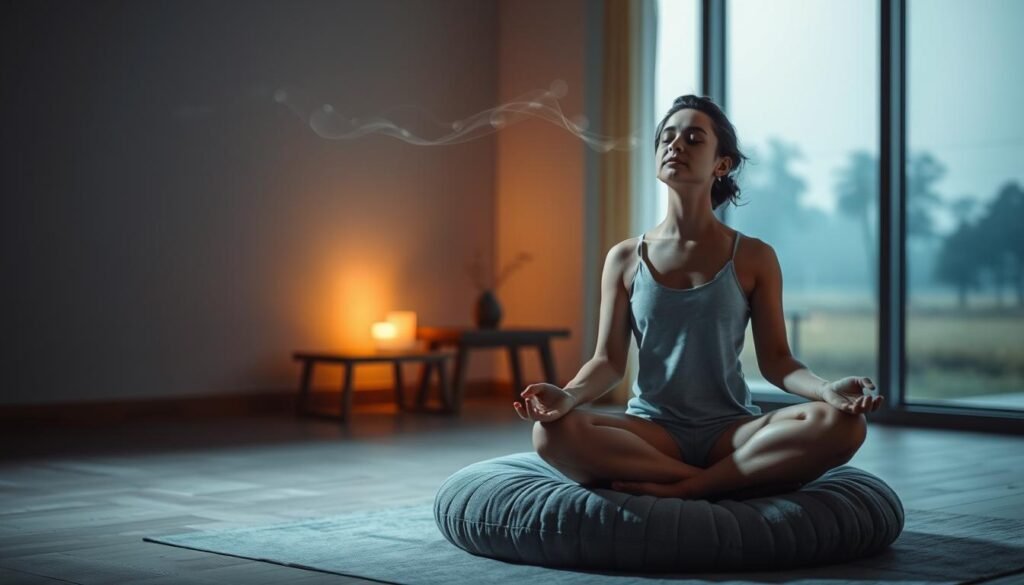
Understanding the Mind-Body Connection in Breathwork
Breathwork affects our mind-body connection by influencing our nervous system. The link between our breath, mind, and body is complex. It involves detailed physiological processes.
The Vagus Nerve and Stress Response
The vagus nerve is key in managing our stress response. It helps turn on the parasympathetic nervous system. This system promotes calm and lowers anxiety.
How Breathwork Activates the Parasympathetic Nervous System
Breathwork exercises can turn on the parasympathetic nervous system. They do this by stimulating the vagus nerve. This leads to less stress and anxiety.
Measuring Vagal Tone
Vagal tone shows how well the vagus nerve works. It can be measured in different ways, like through heart rate variability (HRV) analysis.
Research on Respiratory Sinus Arrhythmia
Studies link respiratory sinus arrhythmia (RSA) to vagal tone. RSA is the change in heart rate that matches our breathing.
| Method | Description | Relation to Vagal Tone |
|---|---|---|
| Heart Rate Variability (HRV) | Analysis of the variation in time between heartbeats | High HRV is associated with good vagal tone |
| Respiratory Sinus Arrhythmia (RSA) | Variation in heart rate synchronized with breathing | RSA is an indicator of vagal tone |
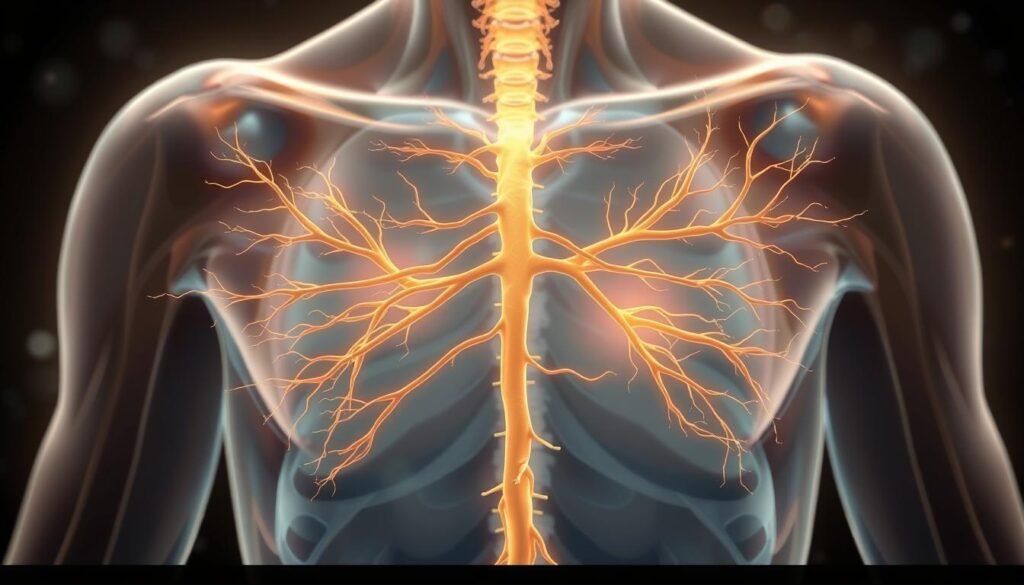
Research-Backed Benefits of Regular Breathwork Practice
A lot of studies now show that breathwork exercises can help lower stress and anxiety. Adding breathwork to your daily life might greatly improve your mental health.
Clinical Studies on Breathwork for Anxiety
Recent studies have looked into how breathwork affects anxiety. The results are very encouraging.
Recent Research Findings
These studies found that regular breathwork can reduce anxiety symptoms.
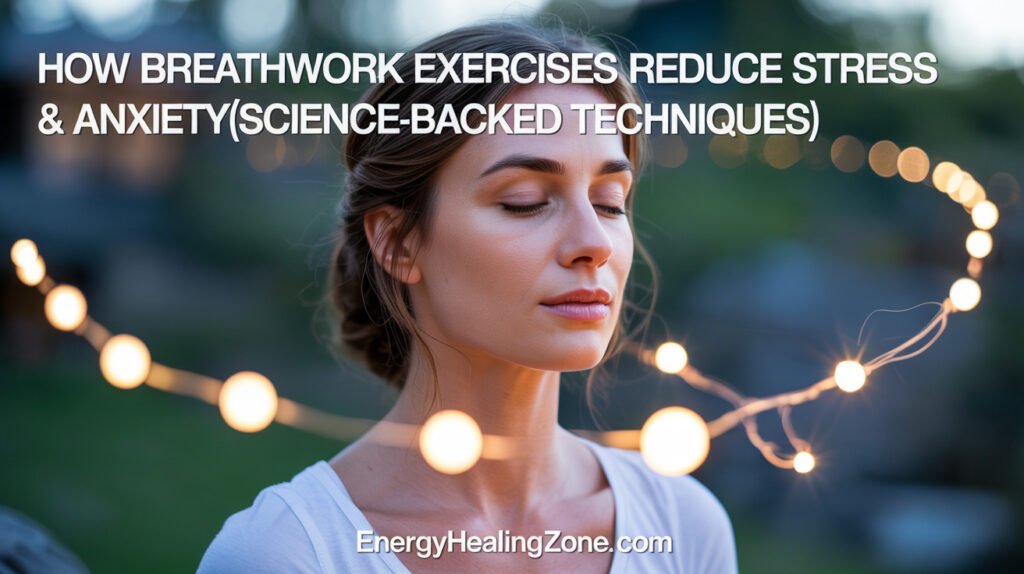
Statistical Evidence of Effectiveness
Analysis of clinical trials shows a big drop in anxiety levels for those who practice breathwork exercises.
Long-term Effects on Mental Health
The long-term mental health benefits of breathwork are being closely studied.
Neuroplasticity and Breathing Patterns
Research shows that regular practice can change neuroplasticity. This affects breathing and mental health.
Learning how breathwork changes the brain and nervous system helps us see its long-term mental health benefits.
Essential Breathwork Exercises for Immediate Stress Relief
Adding specific breathwork techniques to your daily routine can greatly reduce stress and anxiety. These exercises are simple, effective, and fit easily into your busy life.
Box Breathing Technique
Box breathing, also known as square breathing, calms the mind and body. It’s about breathing in for 4 counts, holding for 4 counts, exhaling for 4 counts, and holding again for 4 counts.
Step-by-Step Instructions
- Find a comfortable seated position with your back straight.
- Close your eyes and take a deep breath in through your nose for a count of 4.
- Hold your breath for a count of 4.
- Exhale slowly through your mouth for a count of 4.
- Hold your breath again for a count of 4.
Optimal Duration and Frequency
Begin with 4-5 cycles and increase to 10-15 minutes as you get more comfortable. Practice box breathing during stressful times or as a daily routine.
4-7-8 Breathing Method
The 4-7-8 breathing technique, popularized by Dr. Andrew Weil, is a natural stress reliever that can help you relax quickly.
Dr. Andrew Weil’s Approach
Dr. Weil suggests this technique for its simplicity and effectiveness in reducing anxiety. It involves breathing in through the nose, holding, and exhaling through the mouth.
When and How to Practice
Practice 4-7-8 breathing before bed to improve sleep quality or during the day when you feel stressed. Start with 2-3 cycles and increase as needed.
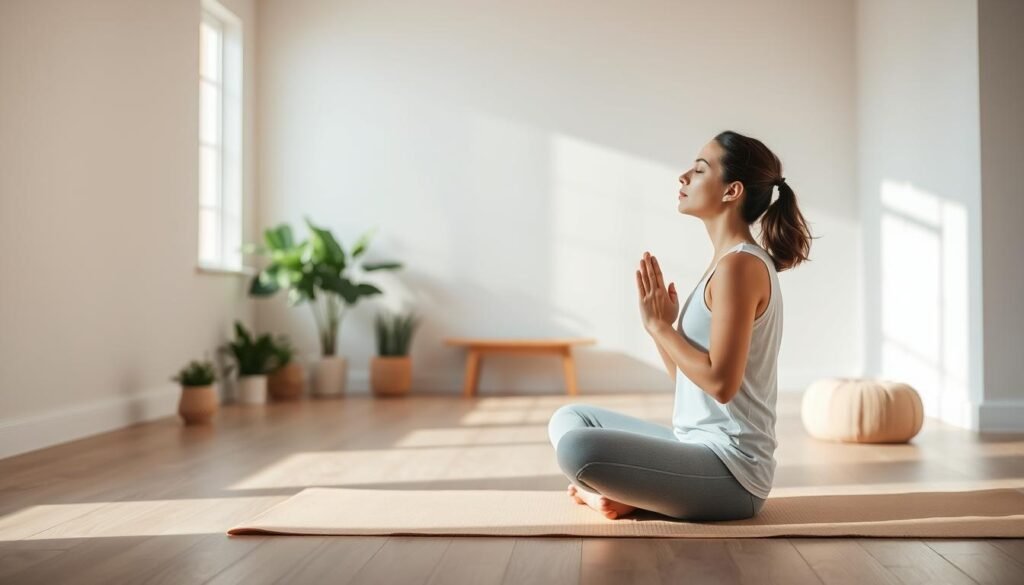
Diaphragmatic Breathing
Diaphragmatic breathing engages your diaphragm, promoting full oxygen exchange and relaxation.
Proper Technique and Posture
To practice diaphragmatic breathing, lie on your back with your knees slightly bent. Place one hand on your belly and the other on your chest. Inhale deeply through your nose, allowing your belly to rise while your chest remains still.
Common Mistakes to Avoid
Avoid shallow chest breathing and ensure your diaphragm is engaged by feeling your belly rise with each inhale. Regular practice will help you develop this natural breathing technique.
Advanced Breathwork Exercises for Chronic Anxiety
Using advanced breathwork exercises can help with chronic anxiety. These methods work by changing how your body’s nervous system reacts. They can be a big help in managing anxiety.

Alternate Nostril Breathing (Nadi Shodhana)
Alternate Nostril Breathing is a yogic practice. It balances your breath and calms your mind.
Traditional Technique
To start, block one nostril with your finger and breathe in through the other. Switch fingers to block the other nostril and breathe out. Keep switching.
Modified Versions for Beginners
If you’re new, try breathing slower or listen to a guided recording. It can make it easier.
Coherent Breathing
Coherent Breathing syncs your breath with a rhythm. This helps your heart and brain work together better.
The 5-5 Method
Breathe in for 5 counts, then out for 5. This rhythm can help lower anxiety.
Using Biofeedback Tools
Biofeedback devices can make Coherent Breathing better. They show you how your body is doing in real time.
Breath Counting Meditation
Breath Counting Meditation is easy but powerful. It focuses on your breath and counting each cycle.
Zen Approach to Breath Awareness
This method teaches you to be mindful of your breath. It helps you feel calm and present.
Troubleshooting Concentration Issues
If your mind drifts, just bring it back to your breath. Don’t worry about it.
Adding these advanced breathwork exercises to your day can help manage chronic anxiety. They give you tools to handle anxiety better.
Incorporating Breathwork Exercises Into Your Daily Routine
Breathwork exercises can be easily added to our daily routines for better health. This way, we can enjoy the benefits of breathwork all day. It helps improve our mental and physical health.
Morning Breathwork Rituals
Starting the day with breathwork sets a positive tone. 5-Minute Wake-Up Protocols are simple. Just take a few minutes for deep, controlled breathing as soon as you wake up.
5-Minute Wake-Up Protocols
Start with slow, deep breaths in and out. Focus on how the breath feels.
Combining with Morning Routines
Link breathwork with your morning coffee or meditation. It makes for a more mindful start.
Midday Stress-Relief Practices
The middle of the day can be stressful. It’s a great time for breathwork to help with stress.
Desk-Friendly Techniques
Try box breathing or 4-7-8 breathing at your desk. It calms your mind.
Micro-Breaks for Breath Awareness
Take short breaks to focus on your breath. It reduces stress and boosts productivity.
Evening Wind-Down Techniques
As the day ends, breathwork helps you relax. It prepares you for a good night’s sleep.
Pre-Sleep Breathing Patterns
Use slow, deep breathing to tell your body it’s time to sleep.
Creating a Bedtime Breathwork Ritual
Make a consistent pre-sleep breathwork routine. It improves your sleep quality.
| Time of Day | Breathwork Technique | Benefits |
|---|---|---|
| Morning | 5-Minute Wake-Up Protocols | Sets a positive tone, increases energy |
| Midday | Desk-Friendly Techniques | Reduces stress, improves focus |
| Evening | Pre-Sleep Breathing Patterns | Promotes relaxation, improves sleep |

Breathwork for Specific Anxiety Triggers
Specific anxiety triggers need special breathwork strategies. Tailoring exercises to certain situations can make them more effective.
Pre-Performance Anxiety Techniques
Pre-performance anxiety is common before big events. Breathwork exercises can help manage this anxiety.
Public Speaking Preparation
Public speakers find box breathing very helpful. It involves breathing in for 4 counts, holding for 4, exhaling for 4, and holding again for 4. This calms nerves and improves focus.
Athletic Performance Enhancement
Athletes can use coherent breathing. It syncs breath with movement or heart rate. This boosts performance by improving heart efficiency and reducing jitters.
Social Situation Breathing Strategies
Social situations can cause anxiety. But, there are breathwork techniques to help. Grounding and discreet methods are especially useful.
Grounding Techniques
Grounding techniques, like diaphragmatic breathing, help focus on the present. They reduce anxiety in social situations.
Discreet Methods for Public Settings
Discreet breathing, like 4-7-8 breathing, can be done in public without notice. It involves inhaling for 4 counts, holding for 7, and exhaling for 8.
Panic Attack Intervention Methods
Panic attacks are overwhelming. But, breathwork can offer quick relief. Emergency response and post-episode recovery are key.
Emergency Response Breathing
During a panic attack, emergency response breathing uses slow, deep breaths. It calms the body’s stress response and reduces panic attack intensity.
Post-Episode Recovery Techniques
After a panic attack, recovery breathing techniques help calm the body. They involve slower breathing and focusing on breath sensations.
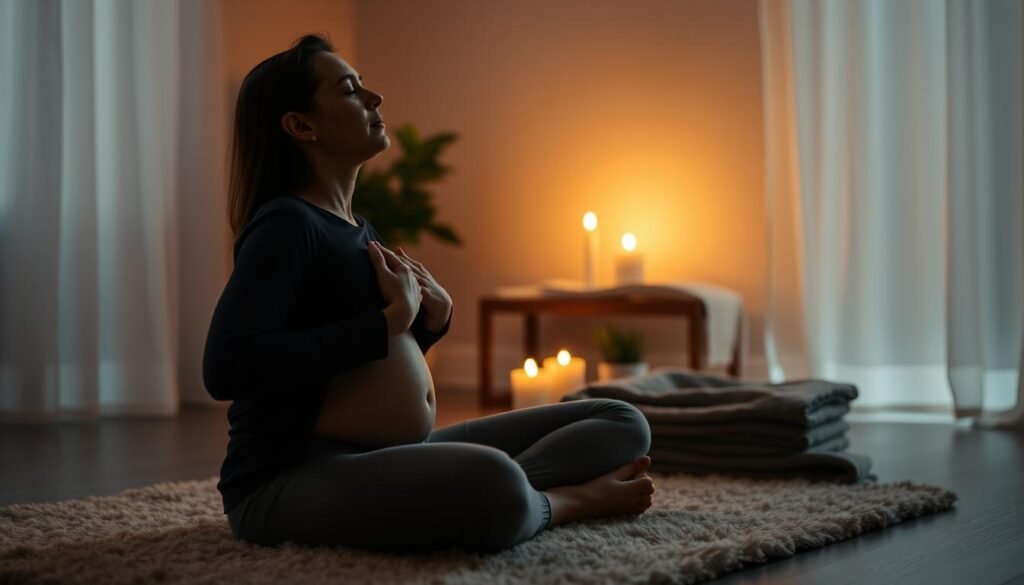
Combining Breathwork with Other Stress-Reduction Practices
Breathwork, when paired with meditation and physical exercise, becomes a powerful stress fighter. Together, these practices create a stronger effect than each alone.
Breathwork and Meditation
Mixing breathwork with meditation deepens relaxation and boosts focus. Breath-focused meditation techniques calm the mind and cut down stress.
Breath-Focused Meditation Techniques
These methods focus on the breath to reach a meditative state. Regular use can better control emotions and lower anxiety.
Progressive Integration Methods
Slowly adding breathwork to meditation makes it more effective. Start with short sessions and increase time to build a lasting habit.
Breathwork and Physical Exercise
Combining breathwork with exercise boosts performance and aids recovery. Pre-workout breathing techniques get the body ready, while post-workout breathing helps relax.
Pre and Post-Workout Breathing
Pre-workout breathing boosts oxygen and focus. Post-workout breathing eases muscle tension and aids recovery.
Breathwork and Mindfulness
Using breath as a mindfulness anchor boosts awareness and presence. Informal breathwork practice throughout the day cuts stress and sharpens mental clarity.
Breath as an Anchor for Awareness
Focusing on the breath grounds us in the present, reducing distractions and increasing mindfulness.
Informal Practice Throughout the Day
Informal breathwork involves quick breath-focused moments throughout the day. It’s easy to do anywhere, making it a handy stress-reducer.
Tracking Your Progress: Measuring the Effects of Breathwork
As we continue our breathwork journey, it’s essential to track our progress. This helps us understand the full benefits of this practice. Monitoring the effects of breathwork exercises helps us refine our techniques and achieve greater stress relief.
Physiological Markers of Improvement
Several physiological markers can indicate the positive impact of breathwork on our bodies. These include changes in heart rate and blood pressure, as well as improvements in sleep quality.
Heart Rate and Blood Pressure Changes
Regular breathwork practice can lead to lower resting heart rates and reduced blood pressure. Both are indicators of improved cardiovascular health.
Sleep Quality Indicators
By promoting relaxation, breathwork can enhance sleep quality. This leads to better rest and recovery.
| Physiological Marker | Pre-Breathwork | Post-Breathwork |
|---|---|---|
| Resting Heart Rate | 72 bpm | 60 bpm |
| Blood Pressure | 130/80 mmHg | 120/70 mmHg |
| Sleep Quality | 6/10 | 8/10 |
Psychological Assessment Tools
In addition to physiological changes, psychological assessments can provide insight into the mental health benefits of breathwork.
Anxiety Scales and Questionnaires
Standardized anxiety scales can help quantify reductions in anxiety levels over time.
Subjective Units of Distress Scale (SUDS)
The SUDS is a simple, self-report measure. It can be used daily to track changes in distress levels.
Creating a Breathwork Journal
Maintaining a breathwork journal is a powerful way to document our practice. It helps us identify patterns and progress.
Daily Practice Documentation
By recording our daily breathwork practice, we can observe how different techniques impact our well-being.
Identifying Patterns and Progress
Regularly reviewing our journal entries helps us recognize improvements. It also helps us identify areas for further development.
By combining physiological markers, psychological assessments, and journaling, we can gain a comprehensive understanding. This understanding helps us adjust our practice for optimal results.
Common Challenges and How to Overcome Them
Practicing breathwork can change your life, but it comes with its own set of challenges. We’ll talk about these obstacles and how to beat them. Starting your breathwork journey can be tough, with many common hurdles to face.
Dealing with Discomfort During Practice
Discomfort can come from physical or mental reasons.
Physical Adaptations
To ease physical discomfort, try changing your posture or use props for support.
Mental Resistance Strategies
For mental resistance, use mindfulness. Acknowledge it and gently refocus on your breath.
Maintaining Consistency
Consistency is crucial for breathwork benefits. Creating a routine helps.
Habit Formation Techniques
Set a regular schedule and have a special place for practice. This helps form a habit.
Accountability Methods
Joining a breathwork group or having a practice buddy boosts motivation for consistency.
Adapting Techniques for Different Needs
Everyone’s needs are different. Adapt breathwork techniques based on physical limitations or stress levels.
Modifications for Physical Limitations
For physical limitations, try gentle or chair-based breathwork as alternatives.
Adjustments for Various Stress Levels
Adjust the intensity and duration of your sessions based on your stress levels.
Conclusion: Integrating Breathwork into Your Wellness Journey
Breathwork exercises are a powerful tool for reducing stress and anxiety. They help us on our wellness journey. By understanding how they work, we can use them to feel better and be more resilient.
Adding breathwork to our daily routine can greatly improve our health. Techniques like box breathing and diaphragmatic breathing can be done anywhere. They offer quick stress relief and help reduce anxiety over time.
We suggest making breathwork a regular part of your wellness routine. Try different techniques to find what works best for you. This way, you can enjoy less stress, clearer thinking, and more calm and well-being.
Remember, breathwork is a journey, not a goal. With regular practice and patience, you can unlock its full potential. It can change your life and improve your overall quality of life. 
FAQ
What are breathwork exercises, and how do they help reduce stress and anxiety?
Breathwork exercises are conscious breathing techniques. They help calm the mind and body. This reduces stress and anxiety by balancing our nervous system.
How often should we practice breathwork exercises to see benefits?
We suggest practicing daily, at the same time each day. This helps you see consistent benefits and builds a habit.
Can breathwork exercises be combined with other stress-reduction practices like meditation or yoga?
Yes, combining breathwork with meditation or yoga can boost their effects. This creates a powerful mix that increases relaxation and stress relief.
Are there any specific breathwork techniques suitable for beginners?
Beginners should start with simple techniques. Diaphragmatic breathing or box breathing are great. They’re easy to learn and can be done anywhere.
How can we measure the effectiveness of our breathwork practice?
You can track your progress by monitoring heart rate and blood pressure. Use psychological tools or keep a breathwork journal. This helps you see patterns and track your improvement.
What are some common challenges people face when starting a breathwork practice, and how can we overcome them?
Common challenges include discomfort or difficulty staying consistent. To overcome these, adapt techniques to fit your needs. Use habits and find ways to stay accountable.
Can breathwork exercises help with specific anxiety triggers like pre-performance anxiety or social situations?
Yes, breathwork can be customized for specific anxieties. Techniques like grounding or discreet breathing can help with pre-performance anxiety or social situations.
